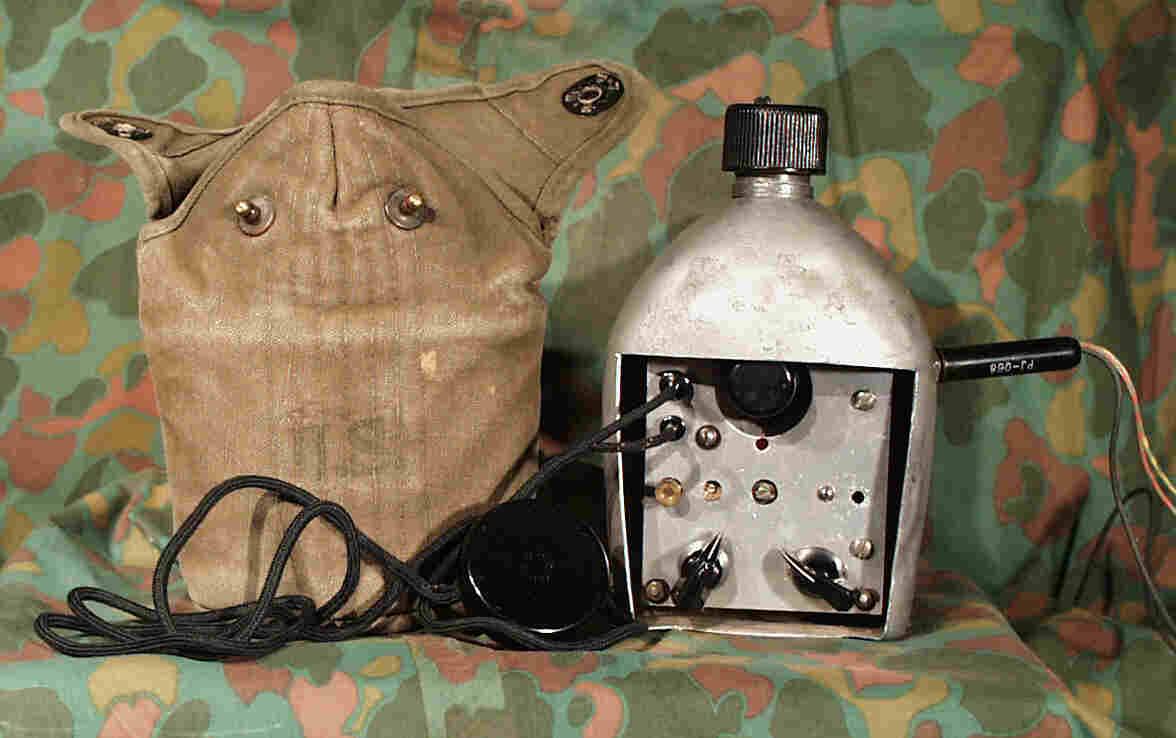
CMS
 |
This set is apparently known as a
CMS. The schematics in the lid of the wooden "painters case" are
labled CMS-T and CMS-R. The frequency charts and the TX and
RX bear the (serial?) number 96H. RX is regen with three
triode connected 3S4's. TX is 2 6V6's in an MOPA
arangement.
Master oscillator may also be crystal controlled. Parts are
clearly of late 30's or '40's US manufacture. No manufacturers
name or military ID anywhere. |
Patience paid off: Here's a copy of the CMS manual (550KB) that, years later, came by way of the Boatanchors mailing list. In typical spook fashion, it gives no indication of manufacturer or country of origin.
WWII Prison Camp Short-wave Receiver
| These
drawings come from United States Army in WWII, The Technical
Services, The Signal Corps: The Outcome, U.S. Government
Printing Office, 1966, pp 274-275. The text follows: |
“Nor was concealed radio activity by Signal
Corps men in the Philippines confined to the guerrillas. There
was
at least one incident of it in prison, involving a radioman, William D.
Gibson, who had received his commission as a lieutenant in the Signal
Corps only a few hours before the fall of Corregidor. A former U.S.
“ham” working in Manila as a civilian radio technician, he had offered
his services to the Army on Corregidor after the enemy invasion
began. But his commission had been delayed till the last hours of
his freedom because the medical officers, busily treating wounded men,
had not given him the required physical examination.
Subsequently,
a prisoner in the Cabanatuan concentration camp, he came into the
possession of a 1-tube regenerative radio receiver improvised by an
officer of the Engineer Corps, Capt. Russell J. Hutchinson, who had
built it of scrap parts and placed it inside a GI canteen.
Hutchinson, on being shifted out of the prison, left it with
Gibson. But the set no longer worked. Its single amplifying
tube, a 12SK7, had burned out. Obtaining a different type of amplifier
tube, a 6J7, stolen by an American sailor who had a prison job in a
Japanese shop, Gibson, rewired the set to accommodate the tube; a
cauterizing iron from the prison hospital served as a soldering
iron. Looking like any ordinary canteen, the radio was kept
hanging at the lieutenant's bed. Japanese inspectors passed it
by,
suspecting nothing. Its antenna was a No. 22 wire woven
inconspicuously into a rope clothesline. Only the headphones had
to be secreted separately. The prisoners furtively operated the
receiver
in the evening, using battery power, which was available in the prison
hospital. The little set brought in radio programs emanating from
Siagon, Tokyo, and San Francisco. Best of all was the Voice of
Freedom broadcast from the Apache after the Leyte Campaign
began. This treasured radio receiver was left behind when the
lieutenant, suddenly freed with other prisoners departed in the
pell-mell of the daring Cabanatuan raid, 30 January 1945.
| Here's my reproduction of the radio. I was suprised that the 12SK7 fit across the narrow dimension of the canteen. I used a straight-forward regen circuit with a tapped coil and antenna coupling via a trimmer cap. It tunes about 5 to 12 MHz. A circuit of this sort will work with as little as 12 volts on the plate. The standard canteen cup covers the opening when it's in the cover. When you pick it up it just feels like a canteen. |  |